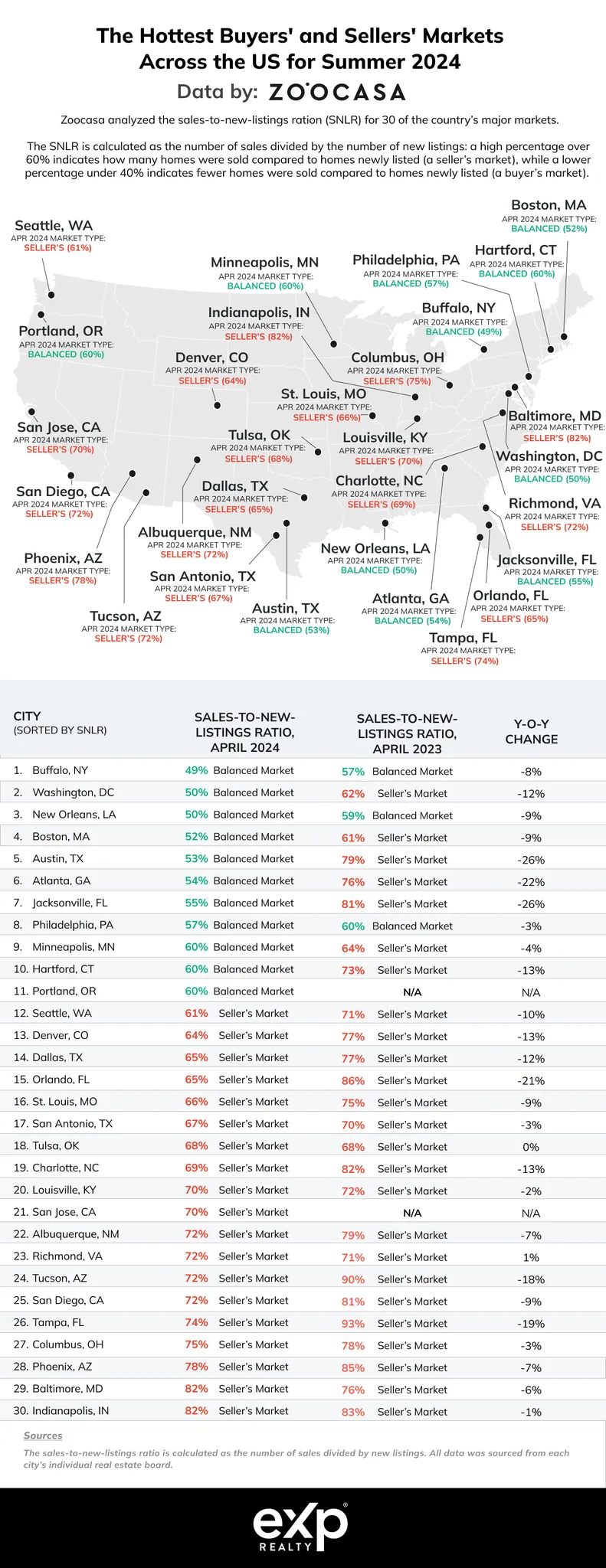This content is written and researched by eXp World Holdings subsidiary Zoocasa. This award-winning prop-tech company uses data and technology to deliver an intelligent, end-to-end real estate experience. View the original article here.
The number of homes available for buyers this season is close to the highest it’s been in a year, with the National Association of Realtors® (NAR) reporting that the national months of supply was at 3.5 months in April. Compared to the spring of last year, when there was just 3 months of supply in April, that’s a significant improvement. During the pandemic years of 2021 and 2022, the housing supply situation was even worse. In 2021 and 2022 there were just 2.3 and 2.7 months of inventory respectively according to NAR.

With more homes to choose from, many US real estate markets are finally balancing out. So which markets have the best conditions for buyers and sellers right now? To find out, Zoocasa analyzed market competition across the US by comparing sales and new listings data for April 2024 in 30 cities. This data was then used to determine the sales-to-new-listings ratio (SNLR) for the month, calculated by dividing the total sales number by the number of new listings in each region. The SNLR is used to show the level of demand and supply in each area, and helps to identify how much competition local buyers face with regard to supply.
The SNLR can be broken down into three percentage parameters:
- An SNLR under 40% suggests a buyer’s market: where new listings outweigh and buyers have more options
- An SNLR between 40% and 60% is a balanced market: where demand and supply are balanced
- An SNLR over 60% means a seller’s market: where demand outpaces supply, benefiting sellers

Cooling Down: US Real Estate Markets Less Competitive Than Last Year
Although the data shows that none of the markets we analyzed are currently favoring buyers, all but two have more balanced conditions compared to 2023. Several large markets, including Boston, Jacksonville, and Atlanta, have transitioned into a balanced market which means the level of supply in these areas is currently meeting the demand. A balanced market leads to more equitable transactions for both buyers and sellers and can contribute to the overall stability of a market.
“This positive increase in supply marks a significant improvement from the highly competitive markets seen in recent years. This should put buyers in a more comfortable negotiating position as demand and market activity has been softer thus far in 2024,” says Carrie Lysenko, CEO of Zoocasa.
Austin and Jacksonville were the two markets that experienced the greatest change in sales-to-new-listings ratio from 2023 to 2024, each dropping by 26 percentage points into balanced markets. Atlanta and Orlando were the only other two markets to see more than a 20 percentage-point drop, with Atlanta’s SNLR decreasing from 76% to 54% and Orlando’s SNLR decreasing from 86% to 65%.
Of the cities we analyzed, Buffalo is the closest to being a buyer’s market with a SNLR of 49%. Washington, DC, and New Orleans follow, both with SNLR’s of 50%. These balanced conditions can be largely attributed to the fact that most markets are experiencing an improvement in the number of new listings on the market. In Buffalo, new listings are up by 16.1% year-over-year, while in Washington, DC, and New Orleans new listings are up by 20.9% and 17.3% respectively.
Finding Opportunities in a Seller’s Market
Conditions in some cities, despite being classified as a seller’s market, have still vastly improved from last year. For instance, Denver and Seattle have both seen their SNLR drop by at least 10%, thanks to new listings rising by over 20% year-over-year in each city.
Tampa is another standout city for improved conditions. In 2023, conditions in Tampa were extremely tight with an SNLR of 93%, but with new listings rising by a whopping 32.9% year-over-year in April, the city’s SNLR was able to soften by 19 percentage points to 74%. Tampa buyers may now find that they benefit from more choices than last spring, though because it is still a seller’s market, competition remains strong.
Indianapolis and Baltimore have the tightest market conditions of the cities we analyzed, with SNLR’s of 82%. Buyers in these markets should be prepared to act quickly and work with a knowledgeable real estate agent to navigate the competitive market. Sellers, on the other hand, can expect strong demand and may even see their home values increase.









